
10 minute read
ACCURATE HUNTER | TEAMWORK: Help or Hindrance?
PROFESSIONAL MEMBER Photos Courtesy of Author
ACCURATE ACCURATE HUNTER HUNTER
TEAMWORK: HELP OR HINDRANCE?
The mule deer, with multiple
bucks in the group, were working their way up a ridge, 300 yards away and gaining ground. It was tough enough to stay on the right deer, but the rifle kept slipping. Things were going downhill fast.
We jumped the deer from a ranch track on the third day. I hopped out and put a jacket on the hood. I’m not proud of this, but it’s 100 percent legal on private land in far West Texas. The truck was tall; I am not. The angle was not lefty-friendly. As soon as I’d get the crosshairs steady, the rifle would start to slide. Not quite in panic mode, I realized this wasn’t going to work.
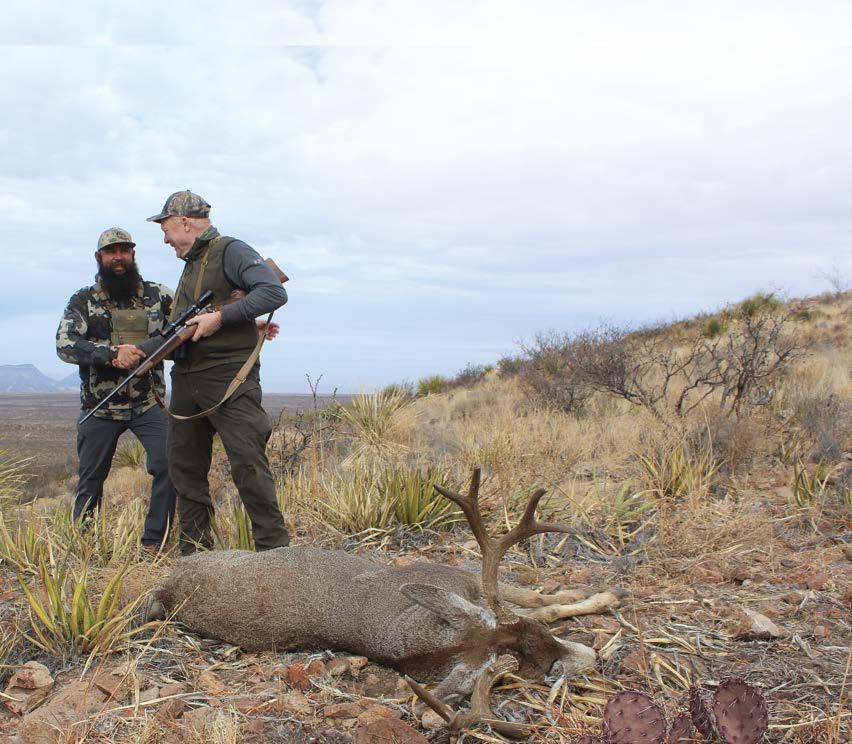
Boddington and guide Steven Ryan with a fine far West Texas mule deer. Teamwork saved the day; Boddington’s shooting position was slipping, no shot possible until Ryan stepped in and put shooting sticks under the rifle butt.
Glassing is very much a team sport, the more eyes the better. Shooting at game is one at a time; usually the best thing a guide or partner can do is stay quiet!
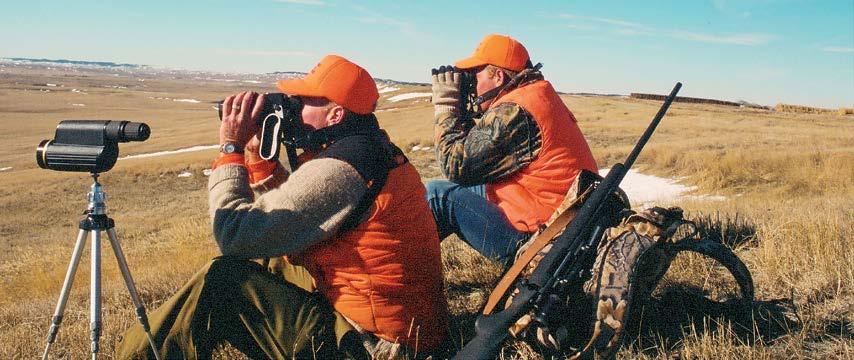
There was too much brush for prone, sitting, or kneeling. There were no tall rocks or sturdy trees. It was the big pickup or nothing. Just behind me, guide Steven Ryan was on his spotting scope doing a great job of keeping me on the largest buck. He couldn’t see my dilemma. I’m not usually helpless, but I needed help. I knew we had shooting sticks somewhere in the rig. “Steven, not steady. Can you grab the shooting sticks and get them under me?” A veteran of 20 years guiding, he instantly understood the problem. In seconds he had shooting sticks wedged under the rifle butt. The problem was solved instantly. In seconds I had the largest buck quartering to me at 325 yards. With the .270 steady, the bullet struck perfectly, and the buck was down in a few steps. In this column I’ve talked about “building your house.” This means assessing, determining options, and utilizing whatever means are available to establish a stable shooting position. There is no “school solution.” How steady you must be depends on distance, size of target, and skill. All must be accomplished quickly. If you hunt alone, all decisions are up to you. Other than natural rests, the only aids are on your person, be it a pack, shooting sticks, bipod, spotting-scope tripod, etc. You do the best with what you have. However, many of us hunt with a partner, sometimes with a guide. When it’s time to take a shot, anything among the party is fair game. I was embarrassed to ask the guide for help, and that was silly. In any group hunting together, there’s one designated shooter at a time. With an opportunity at hand, all resources must be at the shooter’s disposal. Often, the best help available is for
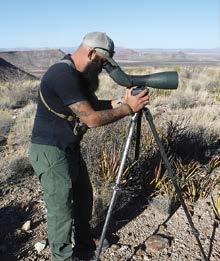
Veteran guide Steven Ryan on the spotting scope. This was exactly where he was—and should have been—when Boddington was trying to shoot a mule deer, watching and keeping quiet. When Boddington’s position slipped and he needed help, Ryan instantly saw the problem and saved the day.
everybody else to shut up and stay still. Other times, building a proper house becomes a construction project. Two sets of shooting sticks are better than one, opening all manner of dead-steady options. The problem is that somebody has to lug them! I love packs, too. Even if just a light fanny pack, few of us venture far from camp, horse, or vehicle without a pack. Stuffed with camera, knives, lunch, raingear, spotting scope and tripod, a pack is ideal for laying across a rock or log. Whether external or internal, a frame pack can be upended and used as a low rest, and any pack can be snuggled against you or into your lap to stabilize your shooting elbow. Sometimes, two or three packs are better than one. On a wet day in southeast Alaska, we glassed a big black bear traversing a series of basins far across a big valley. He was holding much the same course and elevation as we were, so we had the bright idea of intersecting him. We were moving camp (me, guide, and packer), and we fought devil’s club and steep slopes for hours. It was perhaps not the best idea ever, but we finally caught up with the bear during a lull in constant rain. He was across a side canyon at our level, but our ground sloped down so steeply that getting a steady rest seemed almost impossible. Using all of our full packs, we built up a berm. All I had to do was lay across the top pack. It was a successful construction project! In Yukon’s Bonnet Plume Range in 1999, we glassed the best Dall’s ram I’ve seen. It was in a bachelor group along a distant ridge, the gap between us and the rams was steep and awful. We watched them drift over the ridge. Late in the afternoon after a long day, we got to the spot where we had last seen the ram. We were backpacking, so we dropped sleeping bags and tent to lighten the load. After a bit we glassed the sheep in the bottom, far below us. We crept down the ridge to a rocky shelf and peered over. Younger rams were already climbing into cliffy stuff on the next ridge, but the big ram was feeding in a green patch in the bottom. Take it or leave it, gonna be a long shot, better get extra-steady. With a nice flat spot to lie prone, we piled up our two backpacks, but the ram was so steeply below us I couldn’t depress the muzzle enough. My (excellent) guide went back and collected our sleeping bags. I was shooting the
AH
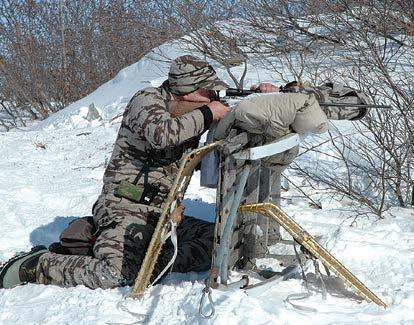
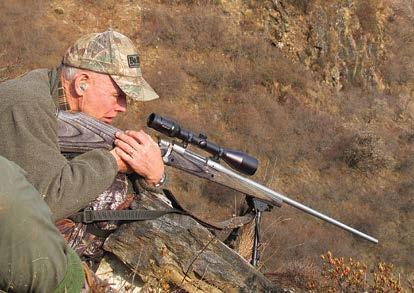
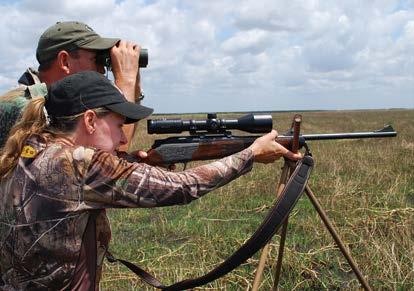
TOP: Bipods are great, and packs are almost always useful. J.Y. Jones has his bipod on a slanting rock, snuggling tight against a pack to keep the rifle from slipping. MIDDLE: A frame pack isn’t the only thing that can be upended to offer a solid low rest. In Arctic Alaska, an overturned sled offered near benchrest stability! BOTTOM: Donna Boddington on sticks, with much taller PH Mark Haldane beside her on binoculars. Proper height is critical with sticks, and what’s right for one person will be very wrong for someone shorter or taller.
big, fast Lazzeroni Warbird, and I knew the drop. The wind was dead calm. I could do this if I could get steady enough. With most of our camp under the rifle, stability was not an issue. The bullet passed through the heart, and our ram was down. There is another side. Shooting at game is an intense and personal moment, and the shot belongs to the shooter. It’s not a group effort, and too many cooks spoil any broth. Folks who hunt alone escape this, but I’ve seen some amazing and unnecessary goat-ropes—well-intentioned, but disastrous. On that mule deer hunt with Steven Ryan, he was doing exactly what an effective guide or partner should be doing: Monitoring the deer through good glass and keeping his mouth shut until I asked for help. Steven instantly saw the problem and sprang into action coolly and calmly. Guides and hunting partners (including parents and spouses) are also hunters and nearly as excited as the shooter. It does nobody any good to jump around and holler, “Shoot, shoot, shoot!” Usually, the most helpful thing any bystander can do is keep his or her mouth shut and stay still. However, if an animal is moving, or in a group, it can be useful to call distances and positions. Especially through a riflescope, keeping track of a fluid situation is difficult. A spotter can be of great help, but only with calm, quiet, and correct information. Our snipers typically work in teams, shooter and spotter. Some teams trade roles; others learn one is the better shooter, the other a more adept spotter. Either way, both roles are equally important. With today’s interest in extreme-range shooting, the shooter/spotter dynamic is constantly trained and employed. People who shoot and hunt together regularly develop teamwork. Brothers Bert and Chris Klineburger hunted the world together and opened up a lot of it for the rest of us. To keep things simple and reduce baggage, they often shared a battered Model 700 7mm Remington Magnum between them. But unless you and your partner have developed teamwork, the best course of action while a person is setting up for a shot is to keep still—unless the shooter asks for help! As for “home improvements,” one of the toughest things with any shooting position is getting the height right. Only exceptionally competent and experienced guides (and partners) will properly take into account a hunter that is significantly shorter or taller. My wife, Donna, is six inches shorter, and even that can make a big difference in proper height and viewing perspective. Most of the time, I’m convinced that the best help a partner can offer is to stay calm, quiet, and out of the way! You can pay attention, and sometimes little things help a lot. Offering a pack or rolled up jacket under an elbow can make a big difference, and having such stuff available to change the height of a rest can save a shot. I love shooting sticks, but the height must be right. Even after 40 years of “stickology,” I can’t tell you how many times I’ve been ready to squeeze when one tripod leg slips. When your supporting hand is forward and shooting hand is on small of stock, you are all tied up. If the animal stays put, recovery is possible, but sometimes there’s nothing to be done. Other times, a watchful partner can step in, adjusting height or trapping the errant leg. Be careful, though. It’s always the shooter’s shot to take, make, or miss. Even best-intentioned interference can mess things up, and strident exhortations usually will! n
George Bird Grinnell Society
The Boone and Crockett Club George Bird Grinnell Society welcomes those individuals who wish to support our conservation programs through purely philanthropic, tax deductible gifts of $2,500 or more.
Funds raised from the George Bird Grinnell Society are placed in the Boone and Crockett Club Foundation endowment where the principal remains intact. The annual interest income generated is then dedicated to vital conservation programs. Special recognition is given via Club publications and in the visitors’ gallery at Boone and Crockett Club Headquarters in Missoula, Montana, and with a custom plaque. After your initial gift of $2,500; gifts of $500 or more to the Boone and Crockett Club Foundation endowment will accumulate toward new contribution levels.

Please join us by becoming a Member of the George Bird Grinnell Society Today!
LEVELS OF GIVING:
COPPER - $2,500 - $4,999 BRONZE - $5,000 - $9,999 SILVER - $10,000 - $24,999 GOLD - $25,000 - $49,999 DIAMOND - $50,000 - $124,999 Wilderness Warrior Society - $125,000 or more
Grinnell Glacier, Glacier National Park
GEORGE BIRD GRINNELL
SOCIETY










